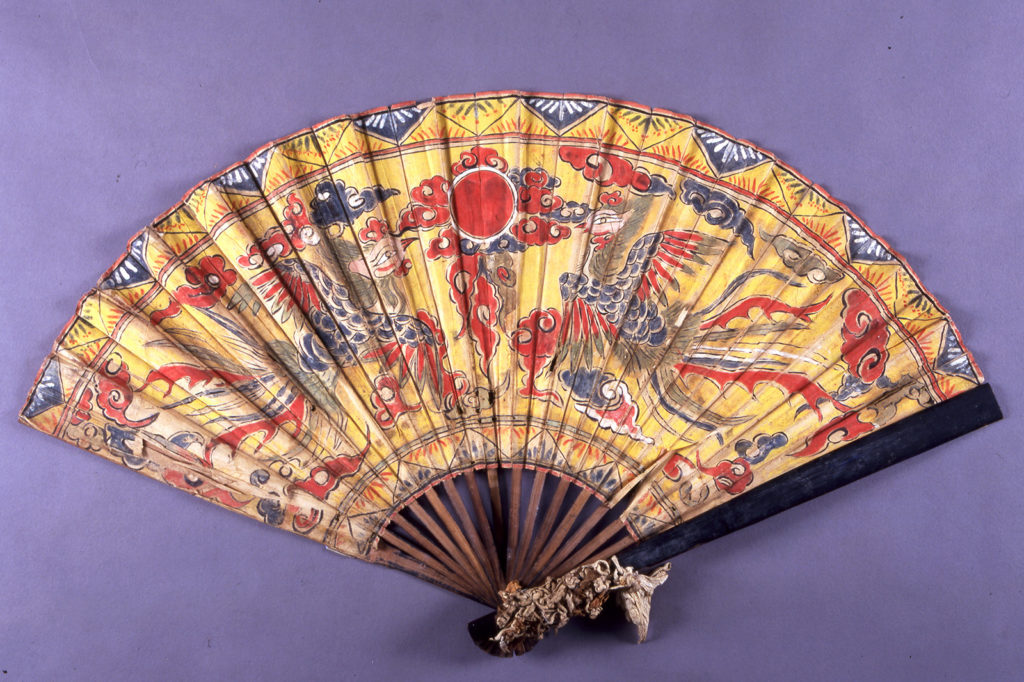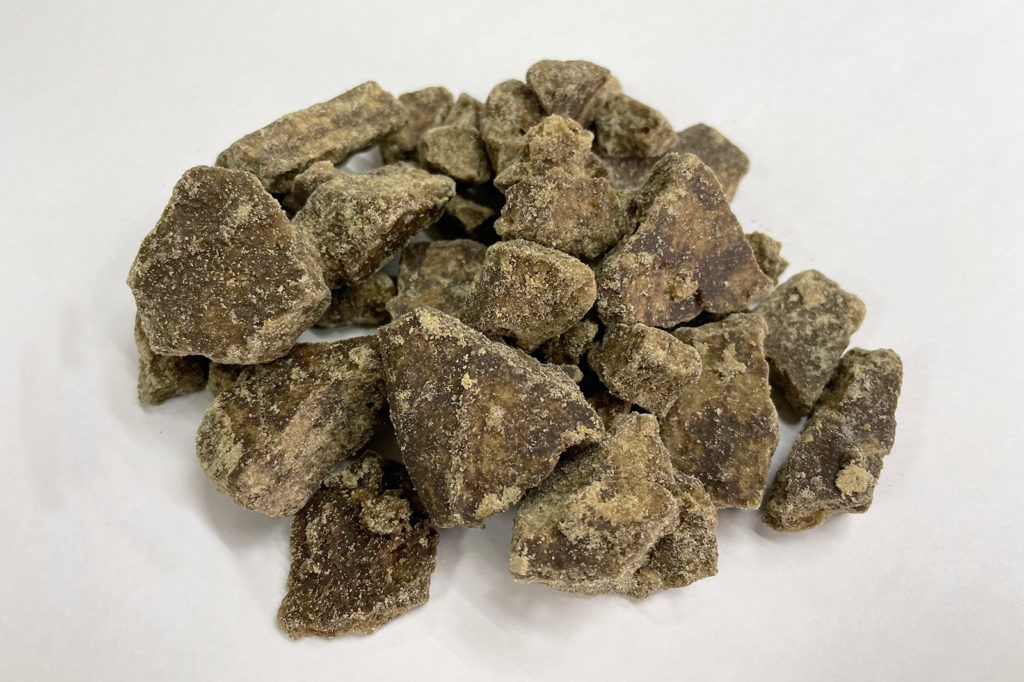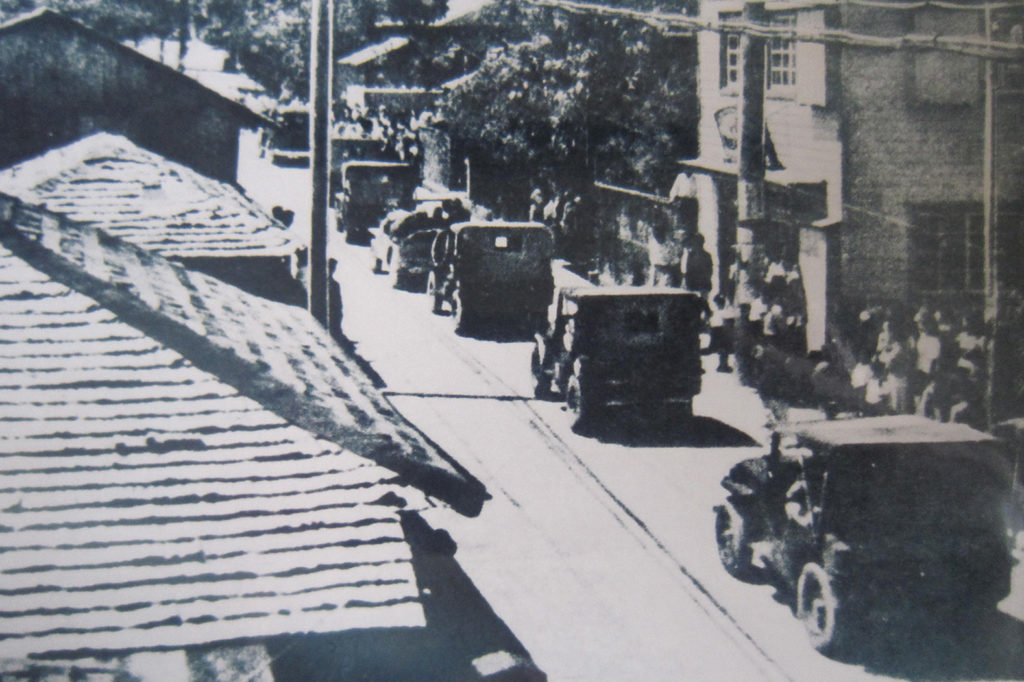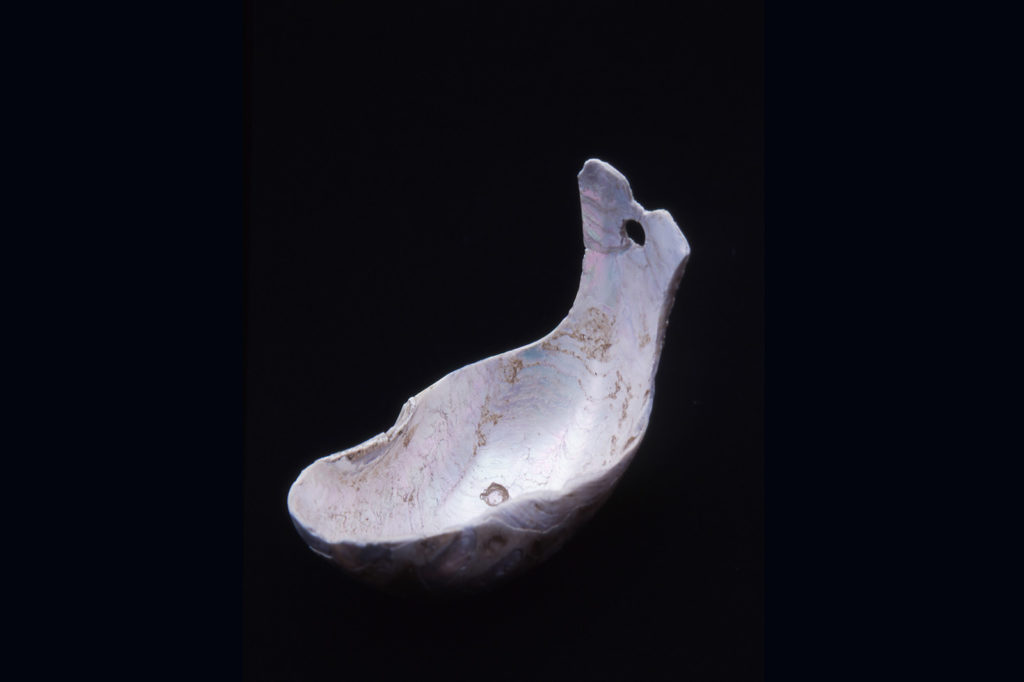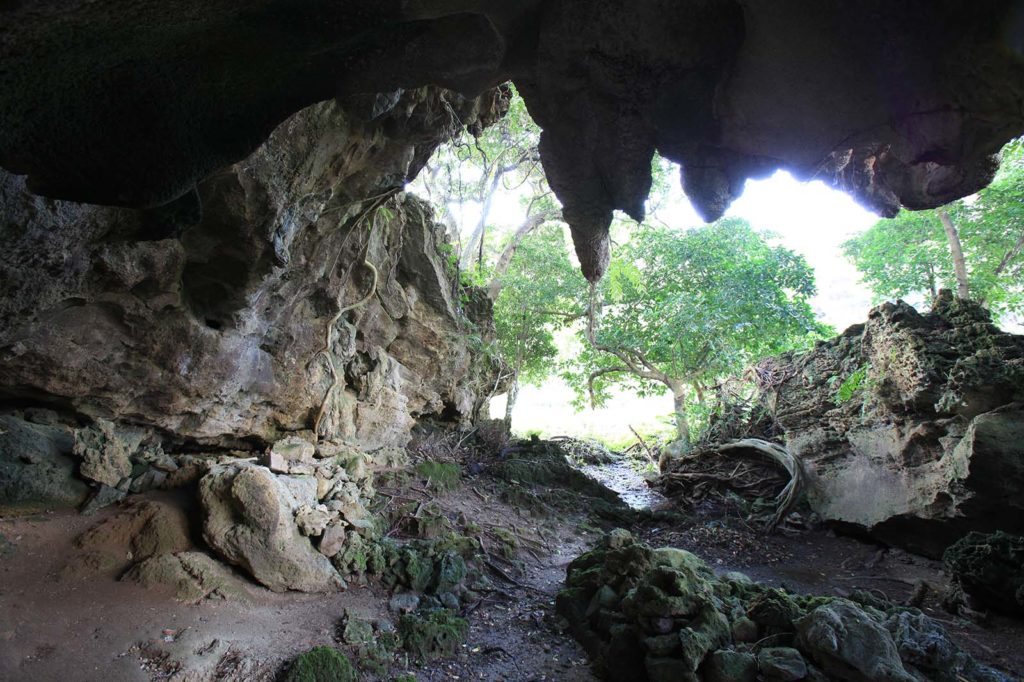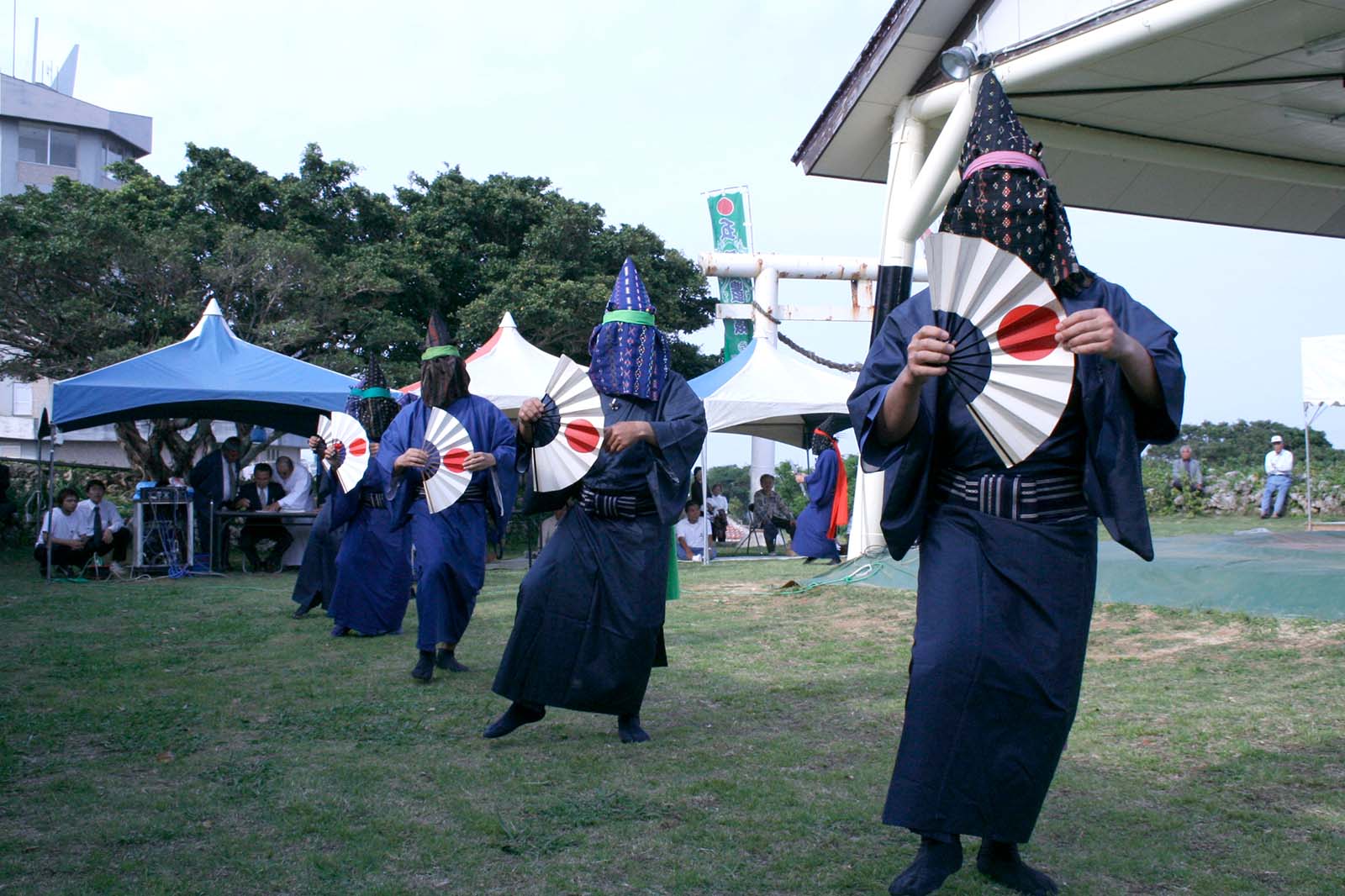
Culture and History
Local Performing Arts of the Amami Archipelago
Points of Appreciation
There are quite a few traditional events on the Amami Islands which are still held according to the lunar calendar. In particular, according to shima-goyomi (island event calendar)between summer and early autumn, covering August and September in the lunar calendar, it is the peak season for harvest festivals and events to honor the elderly. During this time, numerous local performances are held all over the Archipelago. Let us look at points of appreciation for such events.
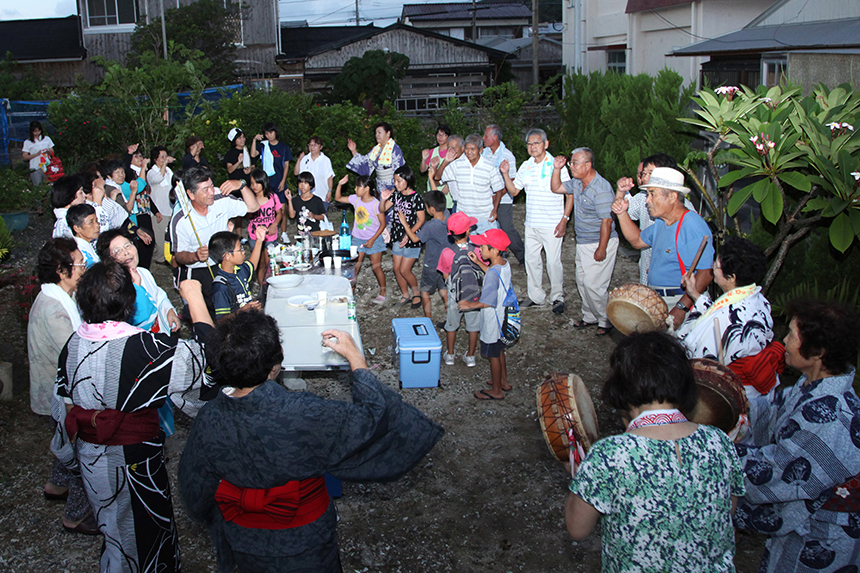
ani-no-hachigatsu-Odori (August Dance in Sani). Women and men forming a circle dance and song. (Amami City, Amami)
The first and foremost representative of the local performance is Hachigatsu-Odori (August Dance), which has been passed on to generations in each of the villages in the northern part of the Amami Archipelago. It involves a traditional music verse form of 8-8-8-6 as in Ryuka (Okinawa type of songs), and is danced in a circle, holding wedge-fastened drums. In particular, Sani-no-hachigatsu-odori (August Dance in Sani) of Kasari-cho (Amami City) and Metegutachi-Odori (Metegutachi Dance) of Isen-cho (Okinoerabujima) have been designated as Kagoshima Prefecture’s cultural properties.
The name August Dance is also referred to as Shichigatsu-Odori (July Dance) or Sen-nin-Odori (Thousand People Dance) in Tokunoshima. Inokawa Natsume Odori (Inokawa-Natsume Dance) of Tokunoshima-cho is danced all night long into the following morning. Other traditional music that has been passed on through the generations in other villages, includes Kometsuki-Odori (Rice-Pounding Dance). It is danced while handing over pebbles during an event called Hamaore (heading to the beach), which is intended to dispel pests in early summer in villages of Sumiyo-cho (Amami Oshima). Another traditional event is Setta Mankai, which is held on in Kasari-cho Setta, is a kind of game played while players would sit opposite to each other and is done during the early New Year’s days in the lunar calendar. When we think of traditional performances, we tend to imagine that there is a division between the audience and the performers; however, with these Amami games, old, young, men and women take part. In other words, the point is that there is no division between the audience and the performers; thereby one cannot be simply observing the performance but will have to join it.
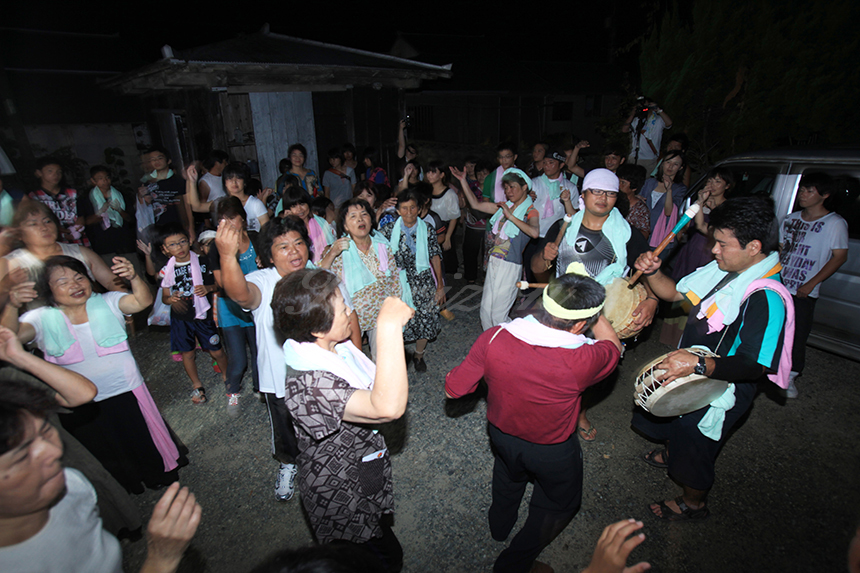
Inokawa Natsume-Odori (Inokawa-Natsume Dance). People dance passionately visiting houses to houses all night long. Men play slightly bigger drums. (Tokunoshima-cho, Tokunoshima)
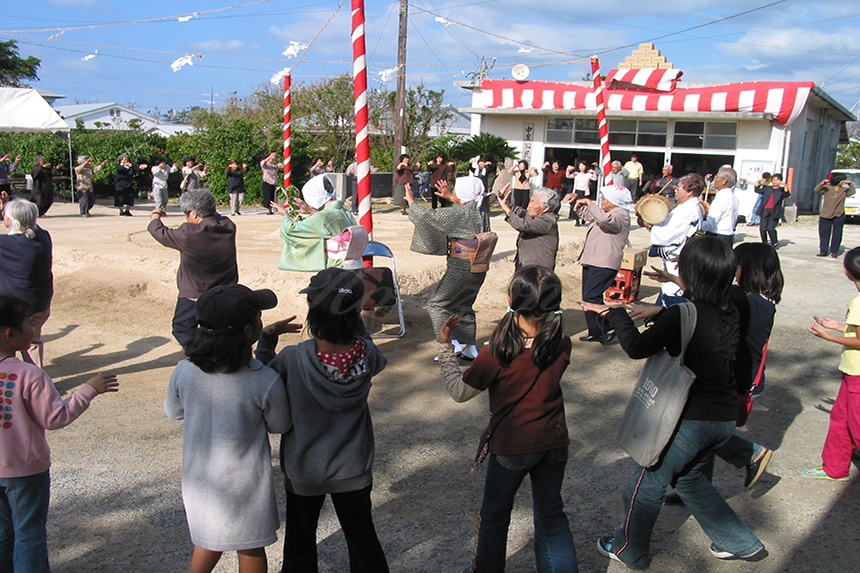
The August dance in Kikaijima maintains a stable rhythm where women are principal dancers. The old and young, men and women dance around a dohyo (an elevated earth ring for sumo tournaments) to dance. (Kikai-cho, Kikaijima)
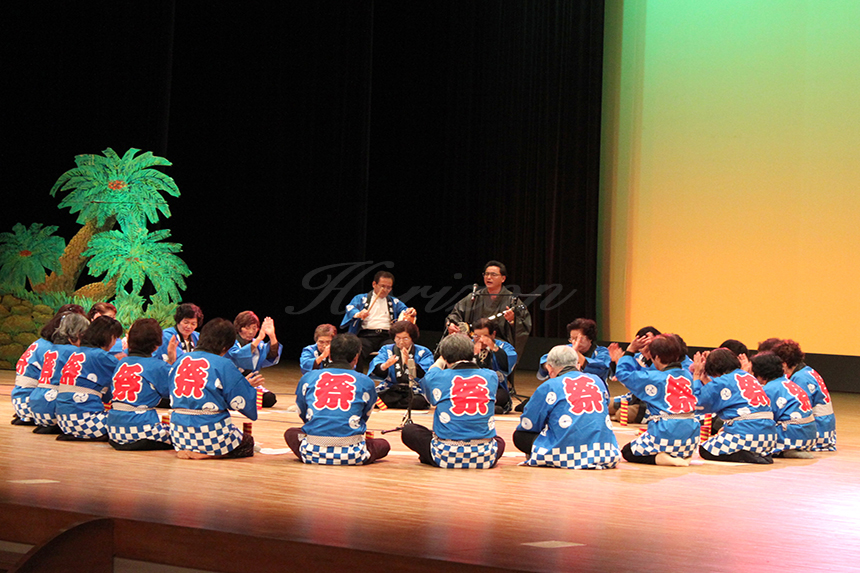
Kometsuki-Odori (Rice-Pounding Dance) is danced while passing a knuckle-size stone to the next people with one’s right hand while singing all at the same time on the sand in a circle (Amami City, Amami Oshima)
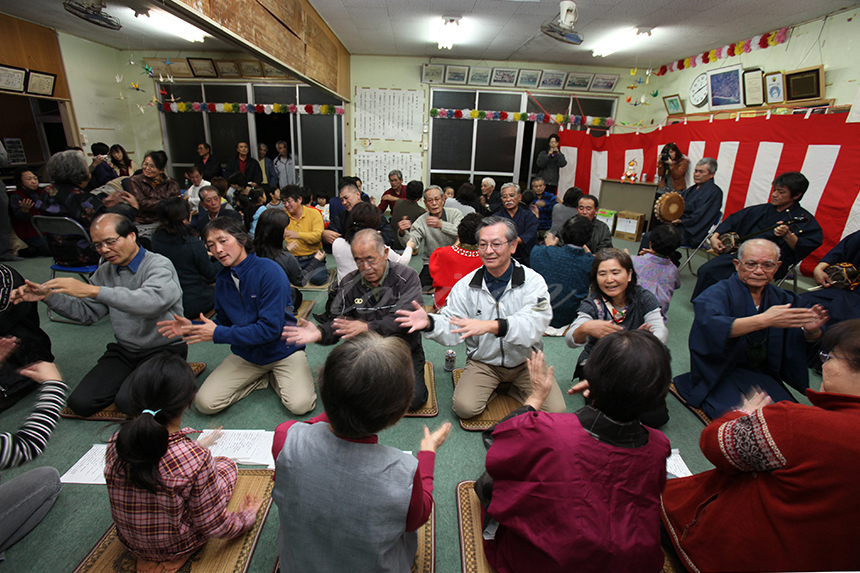
Setta Mankai used to provide a meeting ground for men and women. Mankai means to invite. Participants enjoy this hand dancing while singing to each other. (Amami City, Amami Oshima)
The day of Arasetsu (one day in August in the lunar calendar) is a day set side to thank the good rice harvest and to wish for yet another good harvest for the following year. There are two well-known harvest festivals, Shochogama and Hirase Mankai in Tatsugo-cho Akina which take place on Arasetsu day. In the former, men stand up on a makeshift platform with only half a roof and rock to knock it down at a dawn. The latter takes place in the evening of the same day; people who play the role of gods give a prayer facing the ocean standing on top of two sacred rocks on the beach. This reminds us of the Festival of Noro of Ryukyu. Both of these performances carry remains of the traditional songs and movements that carry ritual and religious significance.

Shochogama is a harvest ritual to pray for an abundance of harvest. Men stand up on a makeshift platform (called Shochogama) with only half a roof and invite Nyahdama (soul of rice) and rock the roof with a shout of “Yoramera” to knock it down. When it goes down to the south side, a good harvest can be expected. The August Dance is performed on the fallen roof. (Tatsugo-cho, Amami Oshima)
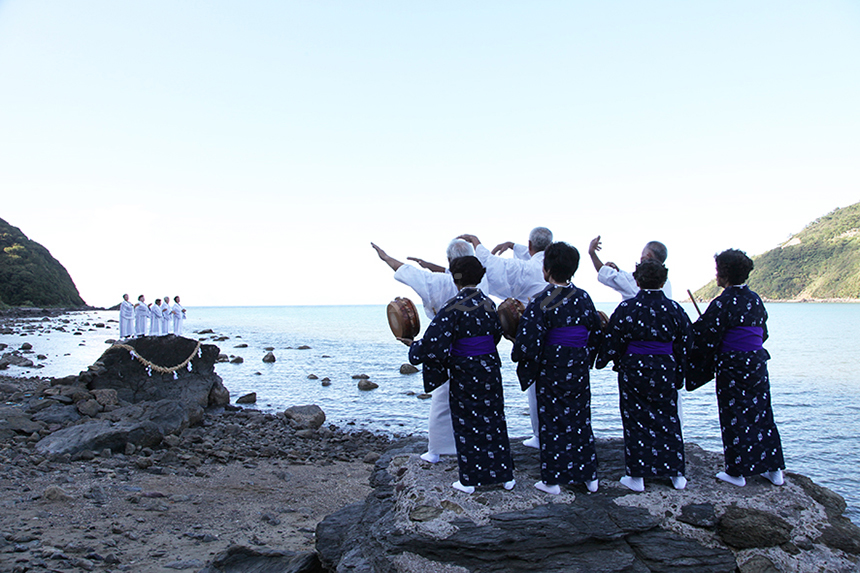
Hirase Mankai is a ritual that takes place at a high tide in the evening of the on the day of Shochogama. Those who play the role of noro stand up on rocks on the beach and invite the Nyahdama from the far away sea by singing to each other. Later, they will dance Susu-dama-odori and together eat the pre-prepared lunch. It has been said that this festival retains classic elements of inviting gods at the turn of a season (Arasetsu), and together they play. Along with Shochogama, Hirase Mankai is also a National Designated Important Intangible Folk Cultural Property. (Tatsugo-cho, Amami Oshima)
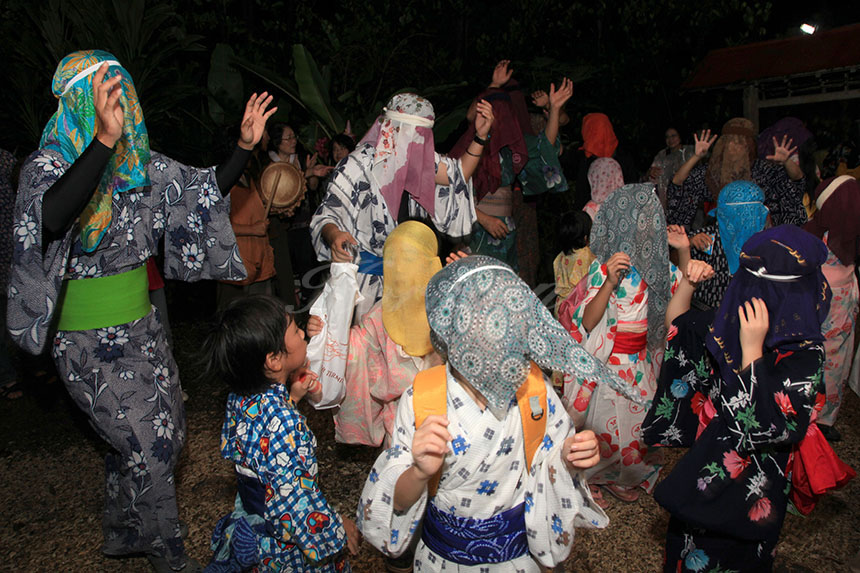
Muchimore -Odori (Muchimore dance) is danced to drive away evil spirits by going from house to house, wearing a furoshiki (wrapping cloth) over the head. People sing and dance to a cheerful "Don-Don" song. Muchimore means " to receive rice cakes". In the old days, when there was a big fire, people used to throw mud from rice fields to extinguish the fire. Thus, it is said that the locals used rice cakes to purify instead of mud. (Yamato-son, Amami Oshima)
The masks donned by local performance on the Amami are also unique. When we think of masks used in performances in Japan, wooden masks as used in the Kagura (Shinto music) or noh performance would come to our minds. However in this region, masks are made of paper. Hosaku Odori (Good Harvest Dance) of Yui, the southern part of Yoronjima, Shodon Shibaya (Shodon Play) of Kakeromajima, and Yoron-jugoya-odori (Yoron Full Moon Night Dance) of Yoronjima are all designated as the national and prefectural cultural properties.
Commonalities in all are: (1) They are performed with masks; (2) Mask bearers are all male; (3) The performance takes place outdoors; and (4) Each performance is made up of several acts which seem to demonstrate the influence of the southern culture of Ryukyu and the north culture of Yamato (Satsuma). However, differences lie in the way each mask is made with different facial expressions, as well as the way of making them.

The Honen-Odori of Yui is an event to appreciate the gods for a bountiful harvest after the rice crop is harvested. It is a humorous and colorful skit-style performance imitating the various tasks after the harvest. This photo captures the first tug of war in which a wild boar appears. (Setouchi-cho, Amami Oshima)
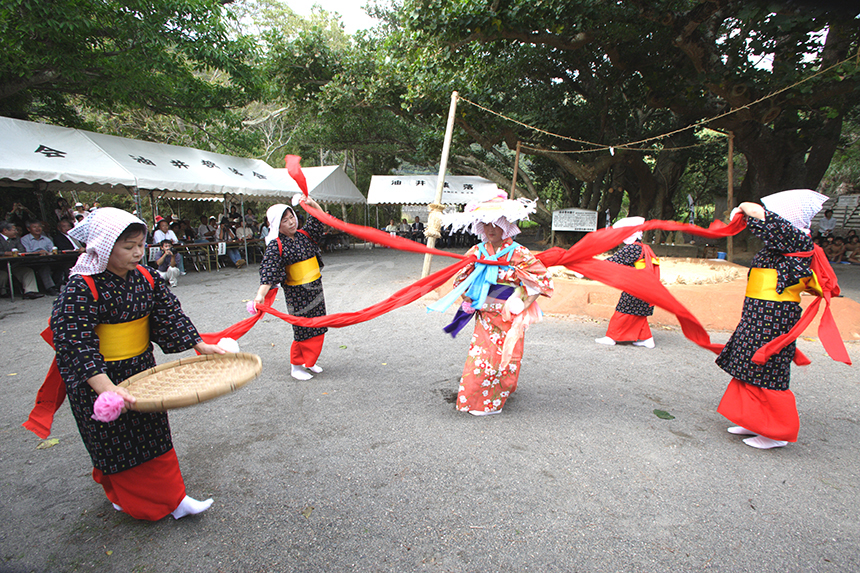
A scene from the Yui Honen Odori depicting a rice grinding scene. The woman in the center plays the role of a mortar.
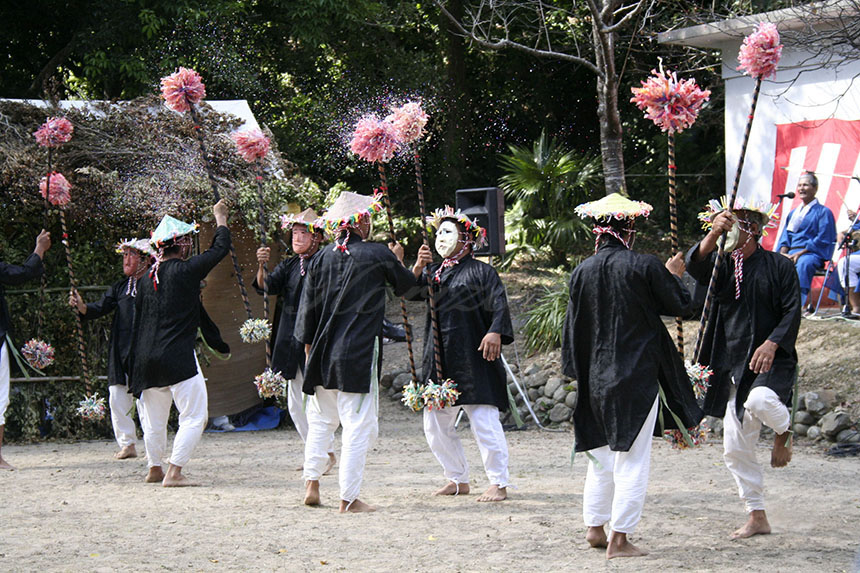
All performers in Shodon Shibaya are male wearing paper masks. The village of Shodon had prospered as a sea route since ancient times and had had the influx of Yamato and Ryukyu cultures. It is said that this performance is a fusion of these two cultures. A theory indicates that the art form which incorporates dance, kyogen and puppetry, is reminiscent of the old kabuki of the Muromachi period. Also it has been believed that this performance has its origin when Taira-no-Sukemori (a military commander who was defeated at the Battle of Dannoura in 1185) performed to interact with the villagers. It is a nationally designated important intangible folk cultural property.
(Setouchi-cho, Amami Oshima)
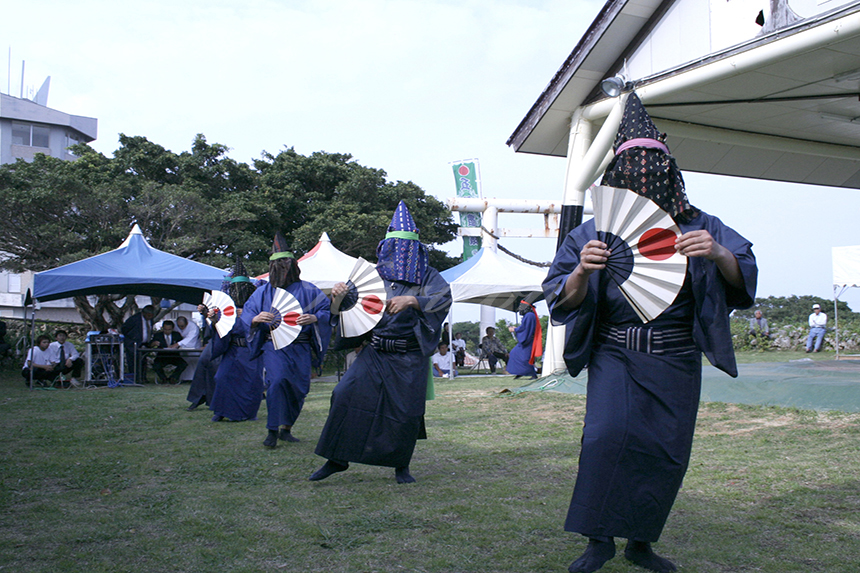
The Yoron Juugoya Odori (Yoron Full Moon Dance) is a ritual performed three times a year at Tokonushi Shrine to pray for peace on the island and a good harvest. According to one theory, Yononushi (the owner of the island in the 16th century) had his three sons research dances from Yamato, Amami Islands, and Ryukyu, and founded this particular dance in 1561. The first group consists of Yamato-style dances and the second group consists of Ryukyu-style ones, and both are performed solely by men. This dance is considered valuable in the history of Japanese and Ryukyuan performing arts and is designated as a national important intangible folk cultural property. (Yoron-cho, Yoronjima)
One of the charms of local Amami performing arts is the way they have created its own style through incorporating cultural impacts from the south and the north in a subtle way and mixing them up with other elements. For example, in the case of Okinoerabu-jima, Kamihirakawa-no-Taija-Odori (Giant Snake Dance of Kamihirakawa) of Chi-na-cho has a popular motif of obsession and hiding, that appears in a traditional Ryukyu Kumi Odori (Ryukyu Combination Dance) or Dojouji (Dojoji Temple), a popular Japanese Noh performance piece. However instead of performing it indoor, the performances in Amami take place outdoors by setting up a massive stage where a giant snake could be seen flying in the sky, while the songs and dance are performed in a theatrical manner. Additionally, Yakko Odori (young folks’ dance) held many places on Okinoerabujima was originally diffused from Satsuma Region in the modern era to which Ryukyu type songs were added to create something original. Figuring out how each of the elements from South and the North is integrated in the traditional local performances of Amami adds another charm in appreciating the culture of Amami.
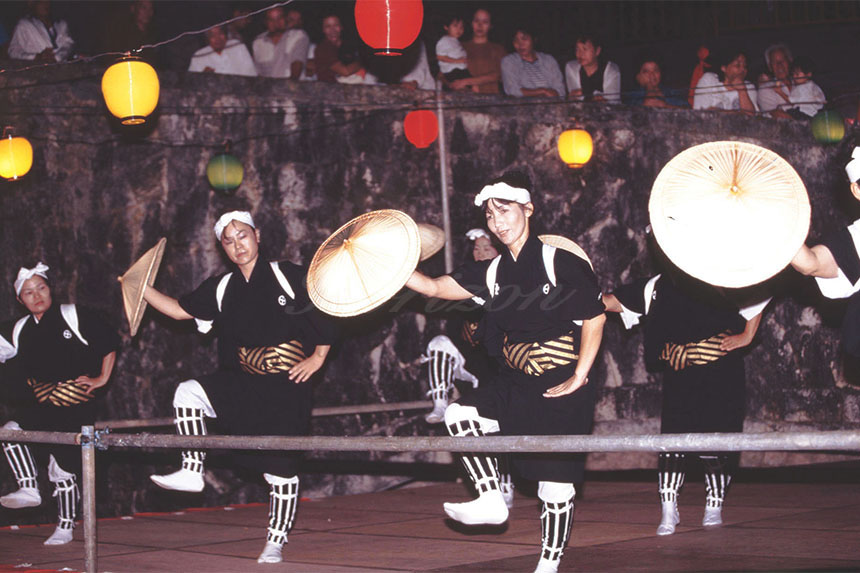
Kamihirakawa Daija Odori (Kamihirakawa Big Snake Dance) is performed in an outdoor-type environment. A snake disguised as a beautiful woman turns up at a temple where women are forbidden and asks for lodging for the night. She is allowed to stay, but later the woman turns into a giant snake and goes on a rampage. When the monk returns, he exterminates the snake with a sutra, and the people celebrate it by dancing together. At the climax of the story, a huge snake appears, breathing fire and full of power, which is spectacular. (China-cho, Okinoerabujima)

Yakko Odori (Yakko Dance) was invented over 400 years ago by a dance lover who combined four dances that he had learned in Okinawa. It expresses the youthfulness and passion of the rural youth through humorous movements. (Wadomari-cho, Okinoerabujima)

Inasuri Odori a dance which is worth seeing for. It depicts the ways the rice is processed in a dace with different movements for each role. (Ukenson, Amami Oshima)
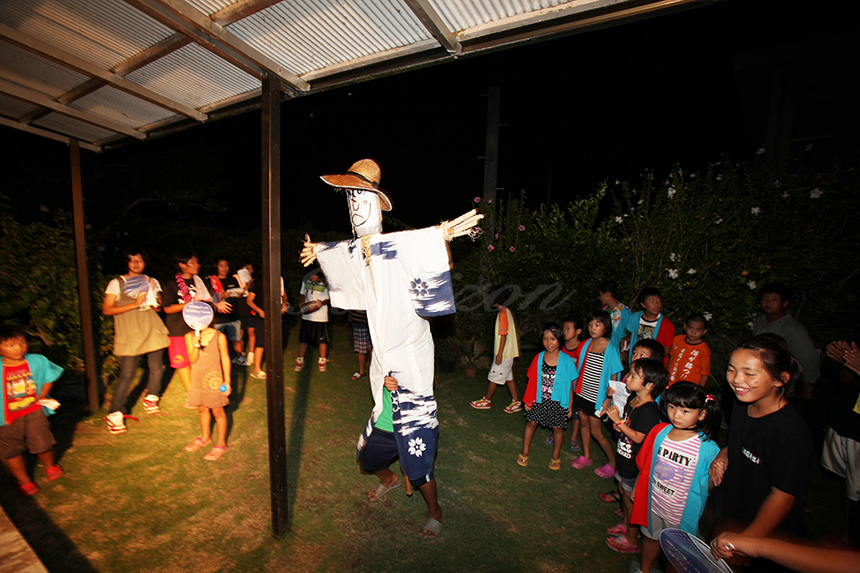
Issan-san is a harvest festival where children lead by a scarecrow called Issanbo wonders around the village blessing the houses. Issanbo is said to signify the god of good fortune. (Isen-cho, Tokunoshima)

